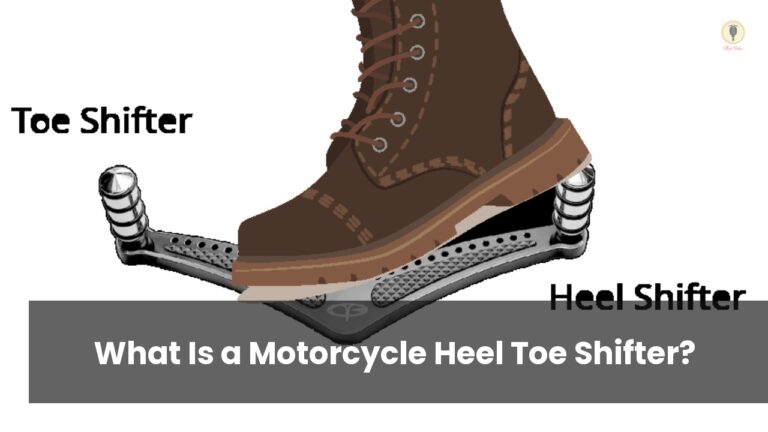A motorcycle heel-toe shifter is a device that allows you to shift up gears with your heel what makes shifting gears so easy, especially when you are wearing boots. However, there’s an extra cost when it comes to installing it and fixing the heel-toe lever. Some people may not like it because they need more space on the floorboards.
To get more detailed information about the heel-toe shifter, please read on!
What is a heel-toe shifter?
A heel-toe shifter on a motorcycle is an additional shift lever attached to the motorcycle behind the traditional toe-shift lever. The heel-toe shifter looks like a reversed toe shift lever that extends to the end of where your foot will rest.
Sometimes, there are usually two different shift levers on the gear shift shaft: the toe and heel shifts. The toe shift lever is placed facing forward, and the heel shift is placed facing backward. In some rare cases, they are placed together, making it look like both levers are a unit.
What is the reason for the Heel-Toe Shifters?
The main reason why the heel-toe shifters are mounted on a motorcycle is to create an easy avenue for gear shifting. The heel-toe shifters make it easier for you to shift between both the toe shifter and the heel shifter by using just your heel. The heel-toe shifter has many advantages. Believe me. And it also doesn’t scuff your boot; I mean, who doesn’t like that. The heel-toe shifter makes it convenient and allows easy access.
Besides, using just the toe shifter lever can create inconvenience. While shifting with a regular toe shifter, you have to constantly move your left foot underneath the toe shifter’s peg. But this is mostly easier on regular street and dirt bikes and can be very complicated for riders who primarily ride cruisers and touring motorcycles.
This is due to the position in which the floorboard is mounted directly under the shifter. This often causes a lack of space for a rider’s feet. Compared to other motorcycles, the cruiser and touring bikes have one significant distinction: the motorcycles require different riding postures and usually feature floorboards instead of footpegs. The riding position on a cruiser has your feet in a different direction than on a sportbike. This is where the heel shifter plays a part. Thanks to creating the heel-toe shifter, you don’t need to put your feet underneath the toe shift peg.
All you need to do is to shift up using the heel shifter. Now would that not be nice and convenient?
But first, we must find out how the heel-toe shifter works.
How the Heel-Toe Shifter works!
Any heel-toe shifter mounted on a motorcycle works simply and easily. This only means that it is easier to understand and use.
Both the heel shift lever and the toe shift lever are easy to use. They faced the opposite directions and therefore worked just like a seesaw. This only implies that pressing the heel shifter downwards will cause the toe shifter to move upwards. As I said, it makes for easier access. If you decide to shift into the lower gear, you can press for your gear to move up and then press down on your heel shift lever with your leg. This causes the object called the shift shaft to turn in the same direction. It is not complicated but easy to grasp.
This object was explicitly made to create less complicated issues for riding a motorcycle and creating utmost convenience so you can control your bike just by pressing on these two gear shifters with your shift.
Using a Heel-toe shifter can be very easy, and I’m just about to tell you how to!
How to use a Heel-Toe Shifter?
Shifting up: press down the heel(back) shifter, or lift the front shifter
While using a traditional toe shifter, a rider will first have to place his left foot under the lever and then lift the shift into the next higher gear.
If the rider uses a heel-toe shifter, the rider can press downward with his heel on the gear lever to shift into the next higher gear or lift the front shifter. The lever is then ejected so that it can reset itself and be convenient for the next shift.
Downshifting: press down the toe(front) shifter
Shifting into a lower gear is pretty much the same process for a standard toe shifter and heel-toe shifter. This occurs simply by pushing the shift lever forward with the ball of the left foot. Immediately the rider re-engages the bike clutch, the shift lever is ejected and resets for the next shift.
What are the advantages of using the Heel-Toe Shift on your motorcycle?
There are a few advantages when it comes to using a heel-toe shift, and they are:
Easy to use
Heel-toe shifters are easy to use. You won’t have a hard time learning to use one. Constantly moving your toes up can be exhausting compared to moving it down with your heel.
This is why using your heel to shift offers much more convenience. This is less tiring for any rider, especially when riding long distances.
Easy to upshift
It makes for easy access to upshift, especially when the toe lever is too low and nearly out of reach. These are most convenient for bikers, mainly in a situation like when your feet don’t fit the space between the toe shifter and the floorboard.
Comfort for disabled bikers
Did I mention it is effective for disabled bikers? It offers enough comfort. For example, riders who have knee, joint problems, and leg injuries can also use the heel-toe shifters without causing more problems. It is just like using automatic and semi-automatic motorcycle transmissions.
Less tiring
It is worthwhile and less tiring. You don’t have to stress yourself much while using it. Many riders have confirmed that using the heel-toe shifter was much more convenient than using the toe shifter.
Boot friendly
The toe shifter will never scuff your boot. Imagine getting new boots and wanting to use them while riding your bike, but they get scuffed! That’s what the toe shifter does; it scuffs your boot. But the heel-toe shifter doesn’t do that; it is designed in a way that stops it from causing any type of damage to your boot.
Disadvantages of Heel Toe Shifters
If there is an advantage, there is a disadvantage as well.
Less room for feet
Riders love changing the positions of their feet on the floorboards. This is necessary as it helps reduce leg and back pain, but the heel-toe shift doesn’t make adequate room for this.
Less space on floorboards
The Heel-toe shift also doesn’t leave enough space on the floorboards.
Extra cost
There’s the extra cost when it comes to installing it and fixing the heel-toe lever.
Installing the Heel-Toe Shift
Installing a heel-toe shifter depends solely on the type of shifter you have acquired. Installation happens by simply bolting the heel-toe shifter to the gear shaft. You have to completely detach the already attached toe shifter before attaching the new levers. If you already purchased a differently better still, separate heel shift, you must mount it at the end of the gear shaft and then move the already attached toe shift lever closer to the engine on the shaft of the bike.
How to remove a mounted Heel-Toe Shifter?
Do you wish to remove your installed heel-toe shift? Well, this is how you do it!
To easily detach a heel-toe shifter from your motorcycle, you have first to loosen the bolts on the sides of the toe and heel shift levers. Then you slide off the levers from the shaft before you put back the toe shift lever on the end of the shaft. You have to remove the heel shift lever without necessarily removing the toe shift lever. Once this is done, it is necessary to fix a “heel shift eliminator”. This is because you need the toe lever to stay in its position on the shaft of the bike.
Adjust the heel-toe shifter
Slide the levers off the shaft and reset them at a favorable angle. You can change the position if the levers are mounted together. If they are separated, you just need to set the angle between both levers.
In Conclusion
The heel-toe shifter is easy to use and convenient, but this decision falls only on the biker or rider. It has its advantages but also has its dark side. It is an excellent addition to their bike for most bikers and offers comfort, and for most other bikers, it doesn’t. The rider can decide on whether or not to use a heel-toe shifter.

